
The Concordat of Worms, sometimes called the Pactum Callixtinum by papal historians, was an agreement between Pope Callixtus II and Henry V, Holy Roman Emperor, on 23 September 1122, near the city of Worms. It brought to an end the first phase of the power struggle between the Papacy and the Holy Roman Emperors and has been interpreted as containing within itself the germ of nation-based sovereignty that would one day be confirmed in the Peace of Westphalia (1648).
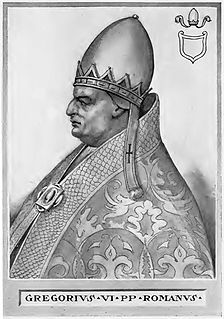
Pope Gregory VI, born John Gratian in Rome, was Pope from 1 May 1045 until his abdication at the Council of Sutri on 20 December 1046.
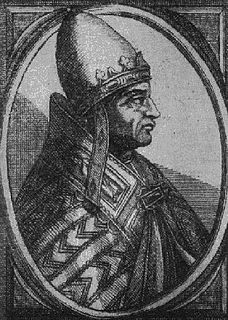
Gregory VIII, born Alberto di Morra, was pope for two months in 1187.
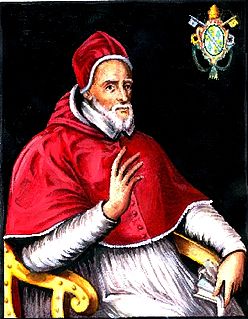
Pope Gregory XIV, born Niccolò Sfondrato or Sfondrati, was head of the Catholic Church and ruler of the Papal States from 5 December 1590 to his death in 1591.
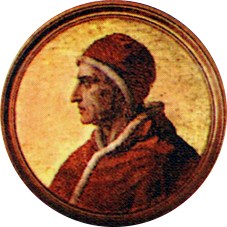
Pope Gregory XII, born Angelo Corraro, Corario, or Correr, was Pope of the Catholic Church from 30 November 1406 to 4 July 1415 when he was forced to resign to end the Western Schism. He succeeded Pope Innocent VII and in turn was succeeded by Pope Martin V.

Pope Gregory XIII, born Ugo Boncompagni, was head of the Catholic Church and ruler of the Papal States from 13 May 1572 to his death in 1585. He is best known for commissioning and being the namesake for the Gregorian calendar, which remains the internationally accepted civil calendar to this day.

Pope Gregory VII, born Hildebrand of Sovana, was pope from 22 April 1073 to his death in 1085.

Pope Leo VII was Pope from 3 January 936 to his death in 939. He was preceded by Pope John XI and followed by Pope Stephen VIII. Leo VII's election to the papacy was secured by Alberic II of Spoleto, the ruler of Rome at the time. Alberic wanted to choose the pope so that the papacy would continue to yield to his authority. Leo was the priest of the church of St. Sixtus in Rome, thought to be a Benedictine monk. He had little ambition towards the papacy, but consented under pressure.

Year 1076 (MLXXVI) was a leap year starting on Friday of the Julian calendar.
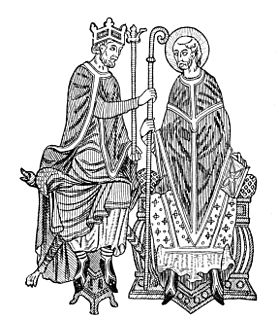
The Investiture Controversy or Investiture Contest was a conflict between church and state in medieval Europe over the ability to install high church officials through investiture. By undercutting imperial power, the controversy led to nearly 50 years of civil war in Germany. According to historian Norman Cantor, the Investiture Controversy was "the turning-point in medieval civilization", marking the end of the Early Middle Ages with the Germanic peoples' "final and decisive" acceptance of Christianity. More importantly, it set the stage for the religious and political system of the High Middle Ages.
The Gregorian Reforms were a series of reforms initiated by Pope Gregory VII and the circle he formed in the papal curia, c. 1050–80, which dealt with the moral integrity and independence of the clergy. The reforms are considered to be named after Pope Gregory VII (1073–85), though he personally denied it and claimed his reforms, like his regnal name, honoured Pope Gregory I.

Guibert or Wibert of Ravenna was an Italian prelate, archbishop of Ravenna, who was elected pope in 1080 in opposition to Pope Gregory VII and took the name Clement III. Gregory was the leader of the movement in the church which opposed the traditional claim of European monarchs to control ecclesiastical appointments, and this was opposed by supporters of monarchical rights led by the Holy Roman Emperor. This led to the conflict known as the Investiture Controversy. Gregory was felt by many to have gone too far when he excommunicated the Holy Roman Emperor Henry IV and supported a rival claimant as emperor, and in 1080 the pro-imperial Synod of Brixen pronounced that Gregory was deposed and replaced as pope by Guibert.

Dictatus papae is a compilation of 27 statements of powers arrogated to the pope that was included in Pope Gregory VII's register under the year 1075.
Gregory VII was Ecumenical Patriarch of Constantinople from 1923 until 1924. He imported the New Style Calendar to the Church of Constantinople. He died suddenly of a massive heart attack in 1924.
Isidore I was the Ecumenical Patriarch of Constantinople from 1347 to 1350. Isidore Buchiras was a disciple of Gregory Palamas.

The papal conclave of 1406, the papal conclave of the time of the Great Western Schism, convened after the death of Pope Innocent VII. It elected Cardinal Angelo Correr, who under the name of Gregory XII became the fourth pope of the Roman Obedience.
Libertas ecclesiae is the notion of freedom of religion of ecclesiastical authority of the Catholic Church from secular or the temporal power, which guided the Reform beginning in the 11th century.
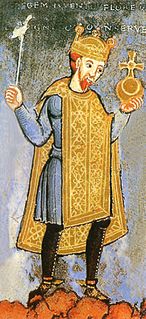
The history of the papacy from 1048 to 1257 was marked by conflict between popes and the Holy Roman Emperor, most prominently the Investiture Controversy, a dispute over who— pope or emperor— could appoint bishops within the Empire. Henry IV's Walk to Canossa in 1077 to meet Pope Gregory VII (1073–85), although not dispositive within the context of the larger dispute, has become legendary. Although the emperor renounced any right to lay investiture in the Concordat of Worms (1122), the issue would flare up again.

The papal election of 1086 ended with the election of Desiderius, abbot of Monte Cassino as Pope Gregory VII's successor after a year-long period of sede vacante.

The papal election of 1073 saw the election of Hildebrand of Sovana as successor to Pope Alexander II.













